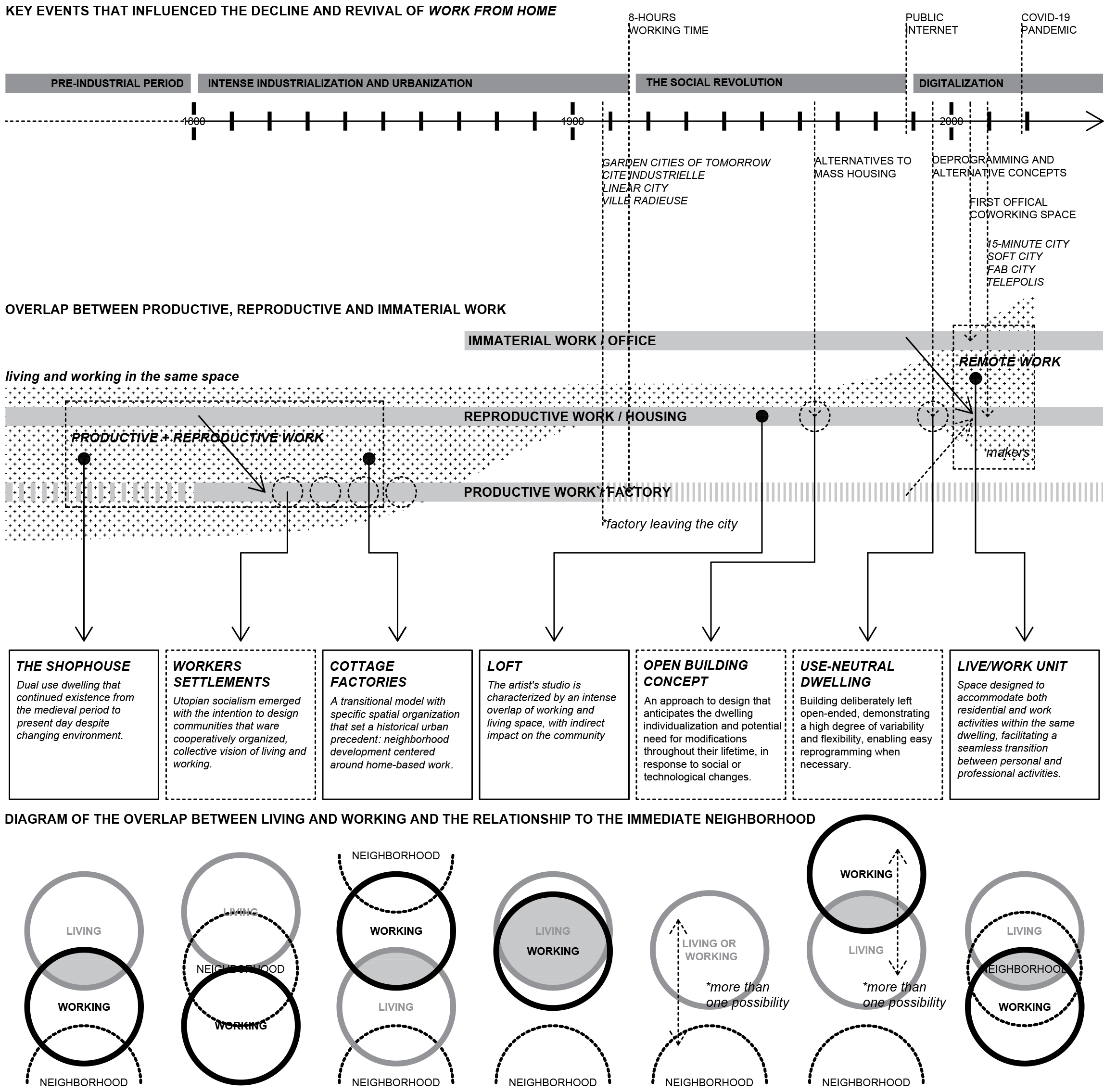Dual-Use Dwellings – Historical Overview
DOI:
https://doi.org/10.31522/p.32.2(68).11Keywords:
Dual-use dwelling, living/working, multi-residential developments, work from homeAbstract
The COVID-19 pandemic in 2020 forced many employees to work from home, and since then, remote work has remained a prominent topic. From an architectural point of view living and working in the same space is a complex issue that challenges the boundaries between private and shared spaces, productive and reproductive work, the home and the city. To address how workspaces can be integrated into residential buildings today, examining the historical background of dualused dwellings is essential. This paper analyzes historical forms of work from home settlements and purposely built dual-use dwellings, with a focus on identifying their basic characteristics, the degree of overlap between living and working spaces, and their relationship with the immediate surroundings. The results show three historical types of dual-use dwellings: integrated into the neighborhood, within the building community, and in the housing unit. With the digital revolution, the high demand for remote work jobs, and a growing interest in work-life balance, it is evident that there is a growing need for further research on the integration of dual-used dwellings within multiresidential developments.
References
Aureli, P.V. (2011) ‘Labor and Architecture: Revisiting Cedric Price’s Potteries Thinkbelt’, Log, (23), pp. 97-118.
Aureli, P.V. and Tattara, M. (2015) ‘Production/ Reproduction: Housing beyond the Family’, Family Planing, Harvard Design Magazine. No 41 F/W Available at: https://www.harvarddesignmagazine.org/articles/production-reproduction-housing-beyond-the-family/ (Accessed: 17 July 2024)
Aureli, P.V. and Tattara, M. (2018) ‘Communal Villa. Production and Reproduction in Artists’ Housing’, ARQ (Santiago), (98), pp. 44-53. Available at: https://doi.org/10.4067/S0717-69962018000100044
Aureli, P.V. and Tattara, M. (2022) Living and working. Cambridge, Massachusetts: The MIT Press.
Baraona Pohl, E. (2017) ‘Cooperative housing as a means more than an end’. In: Kries, M. et al. (Eds.) Together! The New Architecture of the Collective, Vitra Design Museum and Ruby Press, pp. 344-348
Beardsley, S. (2022) Meta goes remote to capture EU talent. DW.com. Available at: https://www.dw.com/en/meta-turns-to-remotework-as-it-expands-across-europe/a-60390423 (Accessed: 21 July 2024).
Bloom, N. et al. (2015) ‘Does Working from Home Work? Evidence from a Chinese Experiment’, The Quarterly Journal of Economics, 130(1), pp. 165-218. Available at: https://doi.org/10.1093/qje/qju032
Bonenberg, A. and Lucchini, M. (2022) ‘Home Office: Working and Studying Spaces in Residential Interiors during and after Forced Social Isolation’, Housing Environment, (39), pp. 98-109. https://doi.org/10.4467/25438700SM.22.016.16594
Bradshaw, R. (2024) Surprising Working From Home Productivity Statistics, Apollo Technical LLC. Available at: https://www.apollotechnical.com/working-from-home-productivity-statistics/ (Accessed: 21 July 2024).
Brownell, B. (2024) An Interview with Pritzker Prize winner Riken Yamamoto, Architect. Available at: https://www.architectmagazine.com/practice/an-interview-with-pritzker-prize-winner-riken-yamamoto_o (Accessed: 17 July 2024).
Caruso, A. (2014) ‘A short history of the development of the office explained in terms of the economic and social context of the last 100 years’, Workforce : a better place to work, 43, pp. 122-143.
Dangschat, J.S. (2022) ‘What does digitalization do to society?’, New Social Housing. Positions on IBA_Vienna 2022., Jovis Verlag GmbH, Berlin, pp. 148-151.
Davis, H. (2012) Living Over the Store: Architecture and Local Urban Life, Routledge & CRC Press. https://doi.org/10.4324/9780203609590 Eurofound and the International Labor Office (2017), Working anytime, anywhere: The effects on the world of work, Publications Office of the European Union, Luxembourg, and the International Labor Office, Geneva.
Gausa, M. (2003) The Metapolis Dictionary of Advanced Architecture: City, Technology and Society in the Information Age. Actar.
Habraken, N.J. (1962) Supports: An Alternative to Mass Housing. 1st edition, Routledge.
Heckmann, O. and Zapel, E. (2017) ‘A Chronicle of Developments in Housing’, Floor Plan Manual Housing, fifth, revised and expanded edition, Birkhäuser, pp. 14-35. https://doi.org/10.1515/9783035611496-003
Holliss, F. (2007) The workhome... a new building type? Doctoral thesis. London Metropolitan University. Available at: https://repository.londonmet.ac.uk/7634/ (Accessed: 6 March 2024).
Holliss, F. (2012) ‘Space, Buildings and the Life Worlds of Home-Based Workers: Towards Better Design’, Sociological Research Online, 17(2), p. 24. https://doi.org/10.5153/sro.2691
Holliss, F. (2015) Beyond Live/Work: The Architecture of Home-based Work. London: Routledge. https://doi.org/10.4324/9781315738048
Judes, A.; Schwellnus, C.; Ciminelli, G.; Koelle, M.; Adrjan, P., and Sinclair, T. (2021) Will Remote Work Persist after the Pandemic? Indeed Hiring Lab. Available at: https://www.hiringlab.org/2021/12/16/will-remote-workpersist-after-the-pandemic/ (Accessed: 21 July 2024).
Junestrand, S. and Tollmar, K. (1998) ‘The Dwelling as a Place for Work’. In: Streitz, N.A.; Konomi, S., and Burkhardt, H.-J. (eds) Cooperative Buildings: Integrating Information, Organization, and Architecture. Berlin, Heidelberg: Springer Berlin Heidelberg, pp. 230-247. https://doi.org/10.1007/3-540-69706-3_23
Kuropka, N. (2022) ‘Coworking spaces in a housing environment - case study’, Housing Environment, (41), pp. 39-49. https://doi.org/10.4467/25438700SM.22.029.17152
Leupen, B. (2006) Frame and generic space. Rotterdam: 010 Publishers.
Leupen, B. (2013) ‘Polyvalence, a concept for the sustainable dwelling’, Nordic Journal of Architectural Research, 19(3), pp. 23-31.
Levy Bencostta, M. (2023) History and Modern Architecture: Prellerhaus, the Bauhaus residential colleges in Dessau (1926-1932). Espacio, Tiempo y Educación, 10(1), pp. 51-75. http://dx.doi.org/10.14516/ete.617
Lipnjak, G. (2012) ‘Rad od kuće - zakonske odredbe, kategorije, prednosti i nedostaci’, Sigurnost: časopis za sigurnost u radnoj i životnoj okolini, 54(1), pp. 21-27.
Lockhart Milan, G. (2023) ‘The architecture of the (post) studio: Jackson Pollock’s barn and Andy Warhol’s Silver Factory’, Frontiers of Architectural Research, 12(2), pp. 266-276. Available at: https://doi.org/10.1016/j.foar.2022.11.001.
López-Igual, P. and Rodríguez-Modroño, P. (2020) ‘Who is Teleworking and Where from? Exploring the Main Determinants of Telework in Europe’, Sustainability, 12(21), p. 8797. Available at: https://doi.org/10.3390/su12218797
McGee, B.L.; Couillou, R.J. and Maalt, K. (2023) ‘Work from Home: Lessons Learned and Implications for Post-pandemic Workspaces’, Interiority, 6(1), pp. 91-114. Available at: https://doi.org/10.7454/in.v6i1.259
Medar, K. and Čurčić, A. (2021) ‘Cohousing and coliving - comparative analysis of two alternative housing typologies by reviewing contemporary trends’, Facta universitatis - series: Architecture and Civil Engineering, 19, pp. 81-92. Available at: https://doi.org/10.2298/FUACE210329007M.
Milasi, S.; González-Vázquez, I. and Fernández-Macías, E. (2021) Telework before the COVID-19 pandemic: Trends and drivers of differences across the EU. Paris: OECD. Available at: https://doi.org/10.1787/d5e42dd1-en.
Mozas, J. (2014) ‘The liquid nature of workspace’, Workforce: a better place to work, 43, pp. 4-21.
Murillo, C. and D’Atri, A. (2018, September) Producing and Reproducing: Capitalism’s Dual Oppression of Women. Left Voice Magazine. https://www.leftvoice.org/on-reproductive-labor-wage-slavery-and-the-new-working-class (16.7.2024.) with citation from: Bhattacharya, T. (2017) ‘Mapping Social Reproduction Theory’, Social Reproduction Theory, London: Pluto Press, p. 2.
Papas, T.; Basbas, S. and Campisi, T. (2023) ‘Urban mobility evolution and the 15-minute city model: from holistic to bottom-up approach’, Transportation Research Procedia, 69, pp. 544-551. Available at: https://doi.org/10.1016/j.trpro.2023.02.206.
Pratt, A.C. (2012) Factory, Studio, Loft: there goes the neighborhood? In: Baum, M., and Christiaanse, K. (Eds.), City as Loft: Adaptive Reuse as a Resource for Sustainable Urban Development, pp. 25-31, Zürich: gta Verlag.
Rappaport, N. (2019) Vertical Urban Factory. 2nd edition. New York: Actar Publishers.
Reuschke, D. and Domecka M. (2018) Policy Brief on Home-Based Businesses, OECD SME and Entrepreneurship Papers, no. 11, OECD Publishing, Paris.
Sim, D. (2019) Soft City: Building Density for Everyday Life. Washington: Island Press.
Terranova, T. (2000) Free Labor: Producing Culture for the Digital Economy, Social Text, 18(2), pp. 33-58. Available at: https://doi.org/10.1215/01642472-18-2_63-33.

Downloads
Published
How to Cite
Issue
Section
License
Copyright (c) 2024 Tamara Relić, Bojan Baletić

This work is licensed under a Creative Commons Attribution 4.0 International License.
Copyright (c) 2021 authors and journal.
This work is licensed under a Creative Commons Attribution 4.0 International License.
Authors who publish with this journal agree to the following terms:
In agreeing this form, you certify that:
- You read the ethical codex of the PROSTOR available at journal web.
- You submitted work is your original work, and has not previously been published and does not include any form of plagiarism.
- You own copyright in the submitted work, and are therefore permitted to assign the licence to publish to PROSTOR.
- Your submitted work contains no violation of any existing copyright or other third party right or any material of an obscene, libellous or otherwise unlawful nature.
- You have obtained permission for and acknowledged the source of any illustrations, diagrams or other material included in the work of which you are not the copyright owner.
- You have taken due care to ensure the accuracy of the work, and that, to the best of your knowledge, there are no false statements made within it.
- All co-authors of this submitted work are aware of, and in agreement with, the terms of this licence and that the submitted manuscript has been approved by these authors.






